
DNA not only determines physical appearance, it determines what special functional attributes a particular plant or animal has. These plants and animals do things no other can do. Do these plants and animals behave like they are related to each other?
At any time, it is estimated that there are some 10 quintillion (10,000,000,000,000,000,000) individual insects alive.
Smistsonian Fun Fact
Insects With Super Powers
Darwins Bark Spider’s Super Web

Scientists have found the toughest material made by life yet — the silk of a Darwin’s Bark Spider whose giant webs span rivers, streams and even lakes.
Darwin’s bark spider (Caerostris darwini) has the toughest silk ever seen — more than twice as tough as any previously described silk, and more than 10 times stronger than Kevlar. Discovered the spider in Madagascar’s Ranomafana National Park in 2001, the spider’s wheel-shaped orb webs could range up to 30 square feet in size, and dangle over streams, rivers and small lakes up to 82 feet across.
The Bombardier Beetle Super Spray
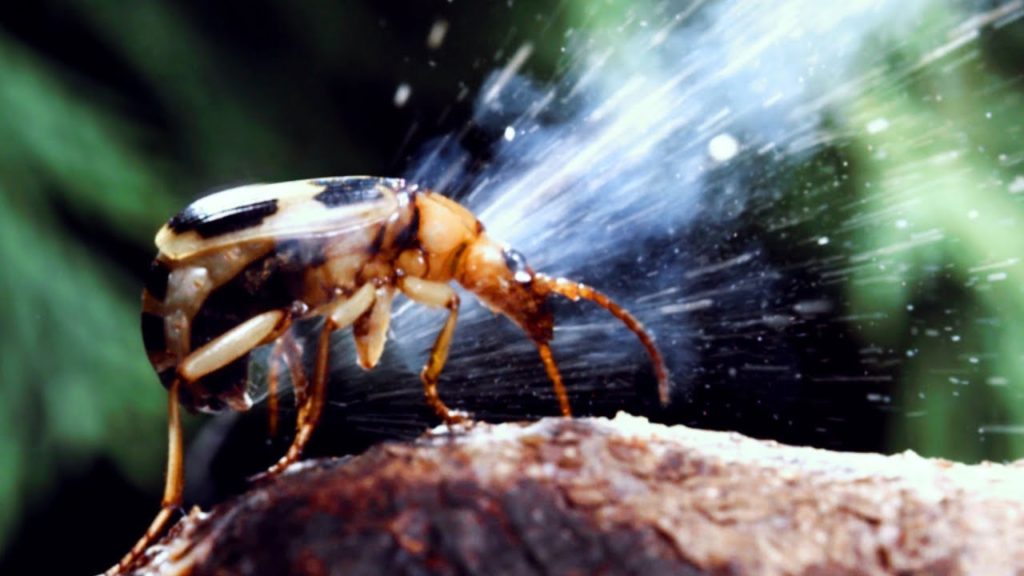
Bombardier beetles have the infamous ability to synthesize and release rapid bursts of stinky, burning-hot liquid from their rear ends to kill or startle predators.
Creating a boiling-hot chemical bomb inside your body is no easy task. These tiny beetles rely on an elaborate internal network of reservoirs and chambers to synthesize their blasts safely.
The beetle’s explosive power is derived primarily from the mixture of two chemical compounds—hydroquinone and hydrogen peroxide—that are stored in separate reservoirs in the abdomen. The chemicals then pass through a valve before meeting in a special chamber, along with an enzyme that catalyzes the reaction.
Beetles can open and close valves to this reaction chamber rapidly, fast enough to produce up to 500 explosive burst in a second.
Cicadas And Super Math

Extreme patience, ultra-precise timing, and clever mathematics help cicadas stealthily avoid their enemies. The insects develop underground for either 13 or 17 years, depending on the brood. Then they emerge simultaneously millions of cicadas in a given region bursting forth all at once and reproduce. Their nymph offspring then bury themselves and wait another 13 or 17 years for their turn to emerge.
Though no one knows how millions of cicadas manage to sync up their extremely long life cycles, it’s clear why they do it: Because they emerge so infrequently, no predators have evolved specifically to live off of eating them. And when they do emerge, there are far too many for predators to eat.
Cleverest of all, emerging in intervals of years that are prime numbers 13 or 17 makes cicadas even more elusive. By definition, prime numbers aren’t multiples of any smaller numbers, and that’s key: “Many potential predators have 2-5 year life cycles,” entomologist Stephen Jay Gould explained “Consider a predator with a life-cycle of five years: if cicadas emerged every 15 years, each bloom would be hit by the predator. By cycling at a large prime number, cicadas minimize the number of coincidences (every 5×17, or 85 years, in this case).” www.livescience.com
Spittlebug The Super Jumper

Ok, so maybe the the name spittlebug isn’t the most appealing, but how about it’s other name: froghopper. This bug can not only jump up to 100 times its own body length, it can do so at incredible speeds. When spittlebugs jump, they can reach the a speed of 13,123 feet per second!
These little bugs even beat out fleas, which are known to be excellent jumpers. Even at their tiny size, they can leap up a full 70 centimeters off the ground. A human jumping that far and that fast could cover a mile in under 10 seconds! That would certainly make for an interesting Summer Olympics!
Firefly Super Morse Code

Fireflies are bioluminescent, meaning they are living creatures that produce light, a trait shared with a handful of other terrestrial insects, including click beetles and railroad worms. The light is used to attract prey and members of the opposite sex and to warn off predators.
Bioluminescence is a cool trick in itself. Even cooler is that fireflies use it to communicate Morse code style. Flash patterns vary from short bursts to long continuous flashing sequences, and each firefly species has its own unique light-up sequence, making it easier for compatible mates to find each other.
The cryptology gets more complicated, though: Even within a species, flash patterns vary. There are over 2,000 species of fire flies, each has it’s own code language.
Desert Locust Super Aviator
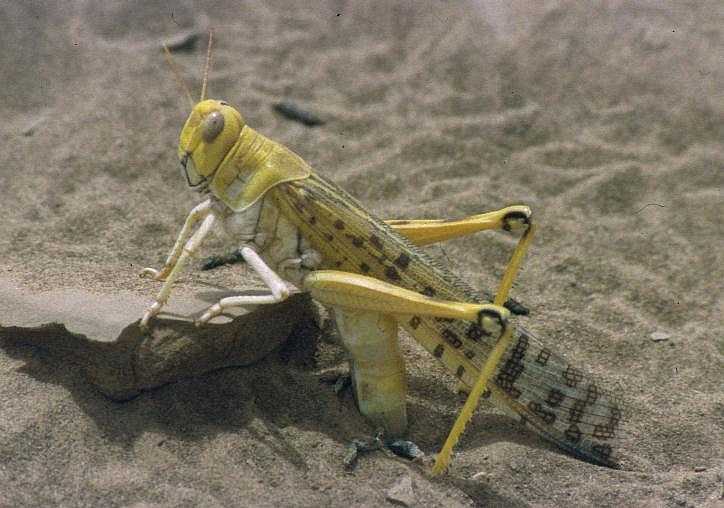
Schistocerca gregaria is also known as the desert locust, and it is one of the fastest insects in the world. While it must be stressed that there may be faster insects, the desert locust is the fastest that has been clocked using a reliable study hitting speeds of roughly 20 mph.
Scientists believe that the locust’s wing deformation in its hindwings helps it maintain a constant angle that reduces drag, allowing for much more efficient flight, but scientists have been unable to mimic anything this efficient in their own systems. For comparison, your average (American) human often has trouble running a mile in 10 minutes, meaning this tiny insect can fly twice as fast as many people can run. listverse.com
Animals With Super Powers
The Pistol Shrimp and Super Bubbles
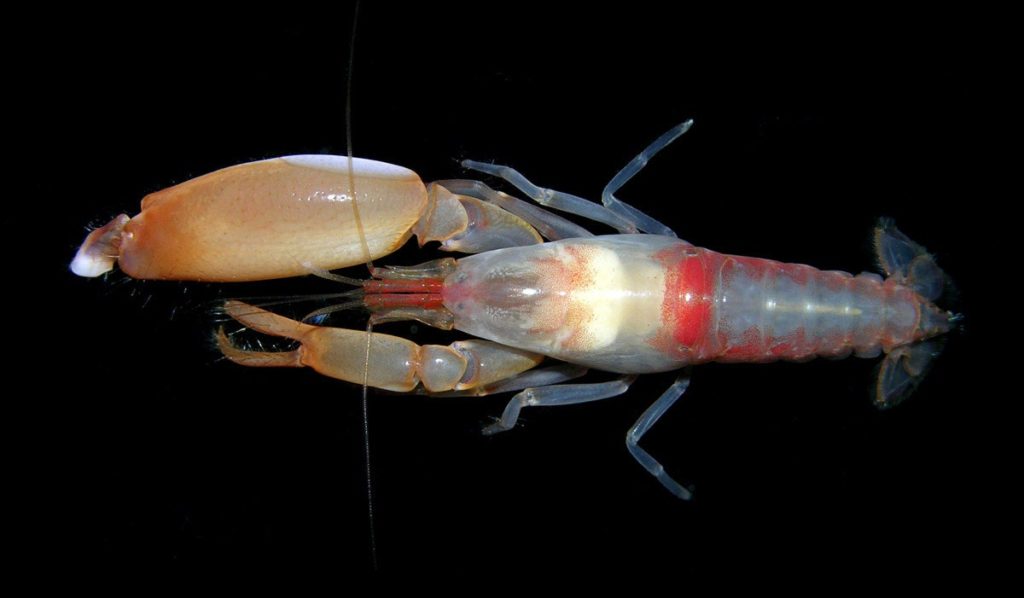
The pistol shrimp has two claws, a small pincer and an enormous snapper. The snapper, which can grow to up to half the length of the shrimp’s body, does not have two symmetrical halves like the pincer. Instead, half of it is immobile, called a propus, which has a socket. The other half, called a dactyl, is the mobile part. It has a plunger that fits into this socket. The shrimp opens the dactyl by co-contracting both an opener and closer muscle. This builds tension until another closer muscle contracts, setting the whole thing off with incredible force.
When the plunger slams into this socket it displaces water that jets out at 105 feet a second, a velocity so high that its pressure drops below the vapor pressure of water.
The collapse of the bubble generates, for a split second, temperatures of 8,000 degrees Fahrenheit, nearly as hot as the surface of the sun, and also, oddly, a flash of light. The resulting shockwave bombards the shrimp’s prey, which if it’s lucky will die instantly.
Lyrebird The Super Mimic
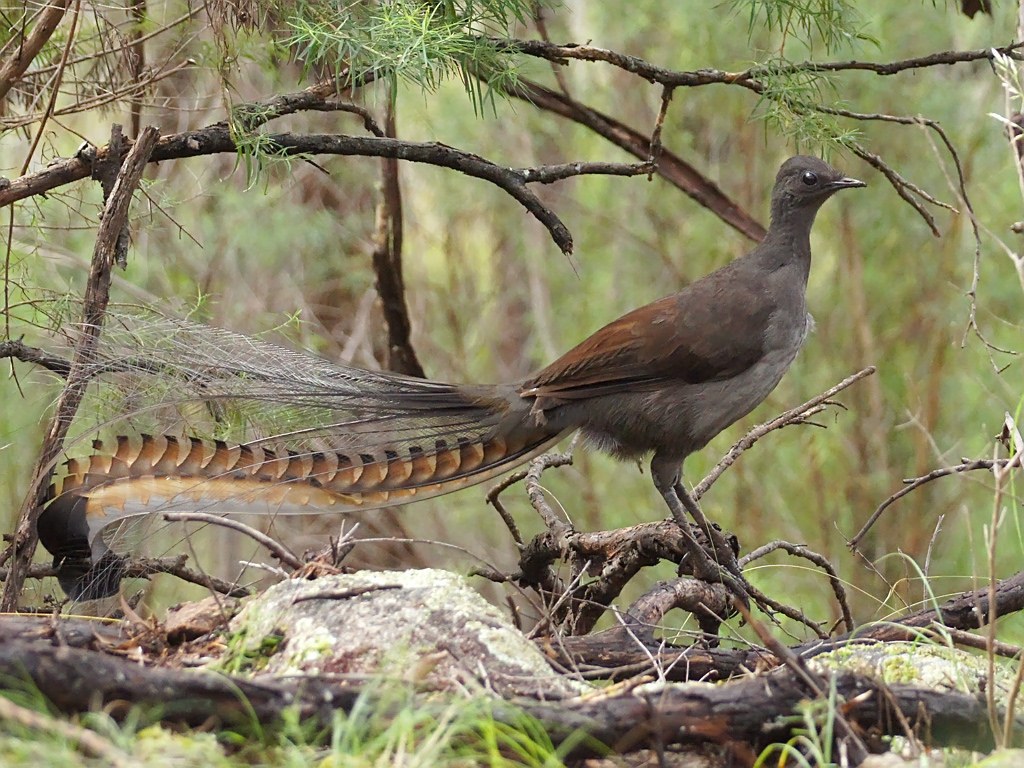
A lyrebird is either of two species of ground-dwelling Australian birds. They are most notable for their superb ability to mimic natural and artificial sounds from their environment. Lyrebirds sing throughout the year, but the peak of the breeding season, from June to August, is when they sing with the most intensity. During this peak they may sing for four hours of the day, almost half the hours of daylight.
The lyrebird’s syrinx is the most complexly-muscled of the passerines (songbirds), giving the lyrebird extraordinary ability, unmatched in vocal repertoire and mimicry. Lyrebirds render with great fidelity the individual songs of other birds and the chatter of flocks of birds, and also mimic other animals such as koalas and dingoes. The lyrebird is capable of imitating almost any sound and they have been recorded mimicking human sounds such as a mill whistle, a cross-cut saw, chainsaws, car engines and car alarms, fire alarms, rifle-shots, camera shutters, dogs barking, crying babies, music, mobile phone ring tones, and even the human voice.
Alpine Ibex The Super Climber

Alpine Ibex are big mountain goats that live among the peaks in the European Alps where predators cannot reach. They occupy the steep, rocky terrain above the tree line between two to three thousand meters above sea level. But they can’t live there at all times, because there is no food up there. During spring and summer, the Ibex live among the conifers and the meadows where there are plenty of grass to feed.
Like many herbivores, the Alpine Ibex lacks salt and other essential minerals in their diet which they can’t get from grass. So the Ibex has to seek out natural salt licks. Dam walls are another precious source of salts and minerals.
Only the Alpine Ibex can exploit this resource. Being excellent climbers, the Ibex will climb the sheer vertical face of the dam’s wall using the small protruding boulders as foothold to lick ettringite off the wall’s surface. The Ibex can scale such great heights because of their soft, split hooves that can grip any surface like a pincer.
Chameleon And Super Vision

Chameleons are primarily known for their super ability to camoflauge. But did you know they have super vision too?
The human visual field covers approximately 50–60 degrees horizontally and 50–70 degrees vertically. To us, this visual field feels pretty decent. It’s hard to imagine being able to see more than what we already can.
However, for the chameleon, the human visual field is laughable. Chameleons are one of two animals which are able to see in full 360-degree vision. (The other is a dragonfly.)
The chameleon has unique eye anatomy, which enables it to rotate its eyes with a high degree of freedom. Another fascinating aspect of the chameleon’s eye anatomy is its incredible talent to switch between monocular and binocular vision. This allows it to view two separate objects with each eye independently or to focus both eyes on one object (which is what we do). listverse.com
Mimic Octopus Super Shape Shifting
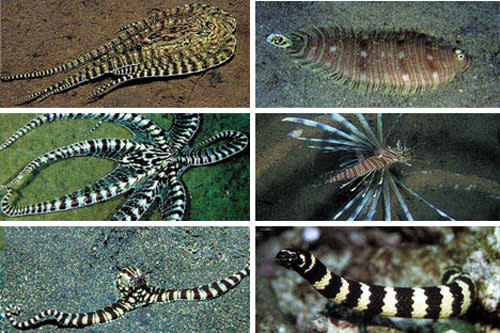
Shape-shifting might sound like something from a sci-fi film, just a made-up concept for entertainment purposes. But actually, there is one incredible animal with the bizarre ability to mimic the shape of other animals.
The mimic octopus is a curious variety of octopus which was first discovered in 1998 off the coast of Sulawesi in Indonesia. Although the ability to change the exterior color of the skin is common to all varieties of octopus, this intelligent creature takes that one step further. It can physically reform itself to appear like a different animal. listverse.com
Blue Whale Super Shout

If you were to shout at the top of your voice, the highest decibel range you could maybe reach would be around 90. The loudest shout ever produced by a human was achieved by an Irish teacher who ironically screamed the word “quiet.” She managed to reach 121.7 decibels.
An incredible achievement . . . for a human, but it has nothing on the blue whale. As the largest creature known to man, it’s hardly surprising that the blue whale is able to produce the loudest sound. But what might surprise you is the amplitude of that sound.
The low-frequency vocalization of the blue whale can reach an incredible 188 decibels. That is much louder than a jet, which peaks at 140 decibels.
In fact, that blue whale’s sound is so loud that it is way above our threshold of pain, which peaks at 130 decibels. The sound is so loud that it can be heard from 500 mi away, which is the equivalent of being heard in San Diego from San Francisco.
Kangaroos Super Fast and Super High

Kangaroos use their strong tails for balance while jumping. They are the tallest of all marsupials, standing over 6 feet tall.
Kangaroos live in Eastern Australia. They live in small groups called troops or herds (“mobs” by Australians), typically made up of 50 or more animals. If threatened, kangaroos pound the ground with their strong feet in warning.
Kangaroos possess powerful hind legs, a long, strong tail, and small front legs.Thanks to their large feet, kangaroos can leap some 30 feet in a single bound, and travel more than 30 miles per hour.
Female kangaroos sport a pouch on their belly, made by a fold in the skin, to cradle baby kangaroos called joeys. Newborn joeys are just one inch long at birth, or about the size of a grape. After birth, joeys travel, unassisted, through their mom’s thick fur to the comfort and safety of the pouch.
Emperor Penguins Super Divers

The emperor penguin is the largest of 17 species of penguin at 45 in. tall. It is also the only animal to inhabit the open ice of Antarctica during the winter.
They face wind chills as cold as -60°C (-76°F) and blizzards of 124 mph. To survive in this severely frigid climate, emperor penguins are equipped with several special adaptations. Four layers of scale-like feathers protect them from icy winds and provide a waterproof coat. The penguins can store large amounts of fat which insulates their bodies while also serving as a long-lasting energy source.
Emperor penguins glide through the water with great speed and agility. Their aerodynamic bodies and strong flippers make them excellent swimmers. They can dive deeper than any other bird – as deep as 1850 ft– and they can stay under for more than 20 minutes.
Facts That Will Change The Way You View the Animal Kingdom
- Koala fingerprints are so close to human’s they could taint crime scenes.
- Prairie dogs kiss and cuddle in public
- Ghost crabs growl using teeth in their stomachs
- The Mantis Shrimp has the world’s fastest punch at 50 mph
- Narwhal tusks are really an “inside out ” tooth
- Peregrine Falcons fly at speeds up to 260 mph
- Whales in the Caribbean have a different accent than whales in other oceans
- Cowbirds use secret passwords to teach their young
- Tasmanian devils make lifelong friends
- A grizzly bear’s bite can crush a bowling ball
- Frogs can freeze without dying
- Dolphins have names for one another
- Reindeers eyes turn blue but only in winter
- Adult cats only meow at humans
- Otters have the worlds thickest fur 1 million hairs per square inch
- Snow leopards don’t roar
- A group of rhinos is called a crash
- Squirrels will adopt orphan squirrels
- Cows have best friends
- An Octopus has three hearts
- A horse can make 17 facial movements, 3 more than chimps, and 10 more than humans
- Deer can run up to 35 miles per hour
- Butterflies taste with their feet
- Wombat poop is cube shaped
- Orca whales can learn to speak dolphins
There is an estimated 7.7 million species of animals on the planet, all with their own DNA code which prevents them from being able to interbreed or evolve into other species. Such original diversity, functionality, adaptability…they all scream DESIGN, ITELLIGENCE, and IMAGINATION
Wonderful Plants That Do Amazing Things
The Corpse Flower

- Name:Amorphophallus titanum, or titan arum
- Nickname:Corpse Flower
- Superpower: Has nauseating flower power
- Curious facts: It is a real giant in the world of plants, as its flowers can rise 9.8 feet above the ground. The flowering of these amazing plants is unpredictable and it always makes headlines when it happens.
- Location: In nature, titan arum is found in the rainforests of Sumatra, while a few these plants can also be found in big botanical gardens.
The Sandbox Tree

- Name:Hura crepitans
- Nickname:Sandbox tree
- Superpower: Exploding fruit with seeds
- Curious facts: The trunk of this tree looks unearthly thanks to huge conical spikes that it uses for self-defense. Its flowers give pumpkin-shaped fruits that open into segments with a loud explosive sound, and throw the seeds up to 46 feet away from the tree.
- Location: This tropical tree is native to the regions of North and South America.
Corpse Lily
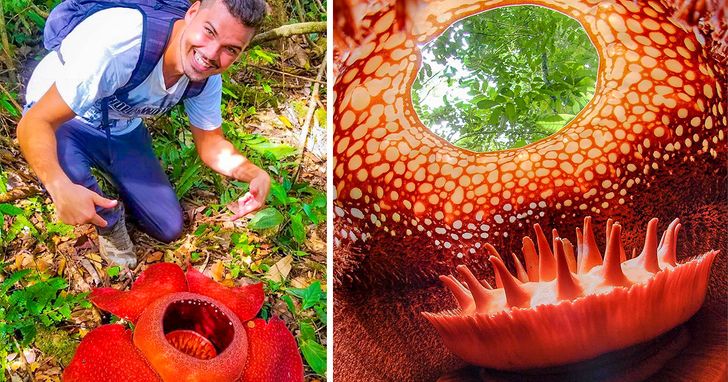
- Name: Rafflesia arnoldii
- Nickname: Corpse lily
- Superpower: Growing on the roots of its host
- Curious facts: It is the largest known individual flower on the planet, reaching up to 3.2 feet in diameter. Rafflesia arnoldii is a parasite. It doesn’t have roots or leaves of its own and grows on the woody stems of its host. The flower uses its revolting smell, that some people compare to the smell of decaying meat, to attract carrion flies who pollinate it.
- Location: You can find this plant growing in Indonesia, or find preserved specimens in botanical gardens.
Sensitive Plant

- Name: Mimosa pudica
- Nickname: Sensitive plant
- Superpower: Closing leaves and drooping
- Curious facts: Anyone who has touched a Mimosa pudica knows that this plant is called sensitive (or humble) for a reason. This curious plant responds to touch by closing its leaves and drooping. These unusual movements can be explained by a quick water release from the cells located on leaflets and leaf stalks. The leaves will normally open up again within a few minutes.
- Location: The plant is native to South and Central America, and widespread in other warm regions.
Whistling Thorn
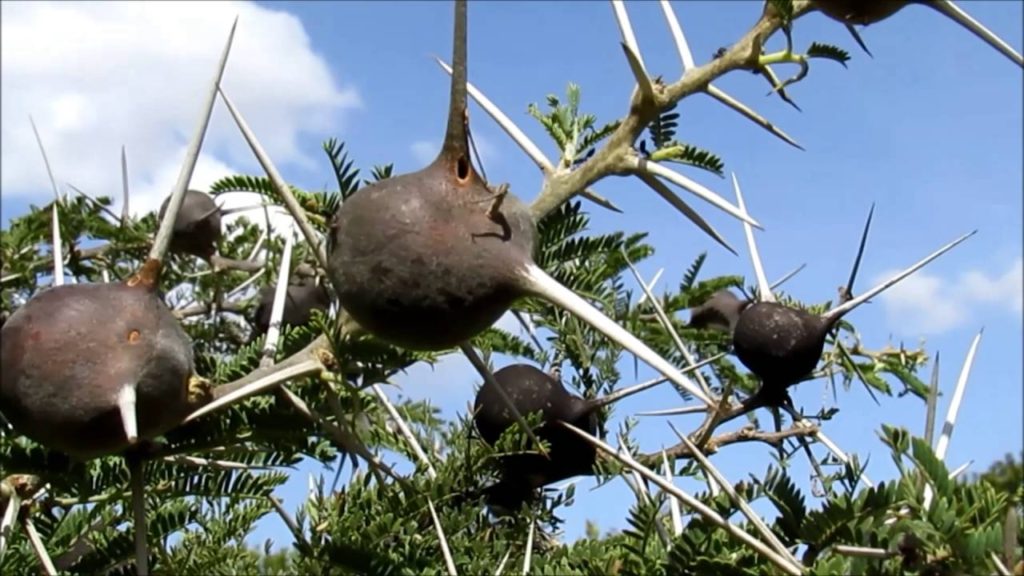
- Name: Vachellia drepanolobium
- Nickname: Whistling thorn
- Superpower: Whistling to keep animals away
- Curious facts: This acacia tree produces a whistling sound from the bulbous bases of its thorns. The most unusual thing about this plant is that it maintains a “friendship” with ants. Both the tree and the ants gain mutual advantages from their symbiosis: ants use the hollow bulbs of the thorns as their homes, and make tiny holes in those bulbs. The holes make the whistling sound that is supposed to keep animals away from the plant’s branches and leaves.
- Location: The whistling tree is native to Africa.
Queen Victoria’s Water Lily

- Name: Victoria amazonica
- Nickname: Queen Victoria’s Water Lily
- Superpower: Can holds weight, up to 99 lbs
- Curious facts: The superpower of Victoria amazonica is hidden inside its huge and incredibly strong circular leaves, which can grow to over 8.2 feet in diameter. The air trapped in the ribs of the leaves allows them to float and hold a large amount of weight. During just one season, each plant produces 40-50 leaves that cover the water’s surface, preventing any other plants from growing.
- Location: Victoria amazonica grows in Bolivia, but you might also see it cultivated in some botanical gardens.
Tropical Pitcher

- Name: Nepenthes
- Nickname: Tropical Pitcher
- Superpower: Catching and digesting insects
- Curious facts: The pitcher shaped leaves of the Nepenthes serve as passive traps. The nectar secreted from the trap’s lid attracts insects and other prey that then slip from the upper part of the pitcher and fall into a pool of liquid at the bottom. Unable to escape, the victims drown and eventually get digested by the enzymes of this carnivorous plant.
- Location: The Nepenthes grows in Madagascar, Southeast Asia, and Australia.
Eucalyptus

- Name: Eucalyptus
- Superpower: Surviving fires
- Curious facts: The leaves of these trees produce large amounts of highly combustible oils and generate a lot of energy when burning. While fire is a disaster for most forest inhabitants, the Eucalyptus uses this disaster to spread its seeds. Fire triggers a massive drop of seeds onto freshly fertilized soil. The trees themselves resist the fire, and their burnt trunks regenerate instead of decomposing.
- Location: Eucalyptus trees are native and common in Australia and often planted in the United States.
Evolution says all life evolved from the same primordial matter…why then are plants and animals inextricably different?
Animal Cell
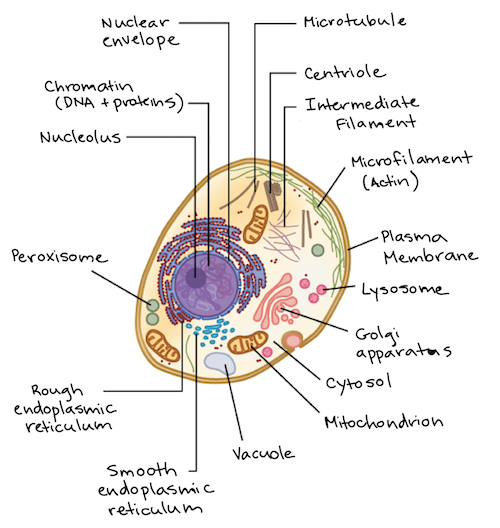
Plant Cell

The Irreconcilable Differences
- Both animal and plant cells have mitochondria, but only plant cells have chloroplasts. Plants don’t get their sugar from eating food, so they need to make sugar from sunlight. This process (photosynthesis) takes place in the chloroplast. Once the sugar is made, it is then broken down by the mitochondria to make energy for the cell. Because animals get sugar from the food they eat, they do not need chloroplasts: just mitochondria.
- Both plant and animal cells have vacuoles. A plant cell contains a large, singular vacuole that is used for storage and maintaining the shape of the cell. In contrast, animal cells have many, smaller vacuoles.
- Plant cells have a cell wall, as well as a cell membrane. In plants, the cell wall surrounds the cell membrane. This gives the plant cell its unique rectangular shape. Animal cells simply have a cell membrane, but no cell wall.